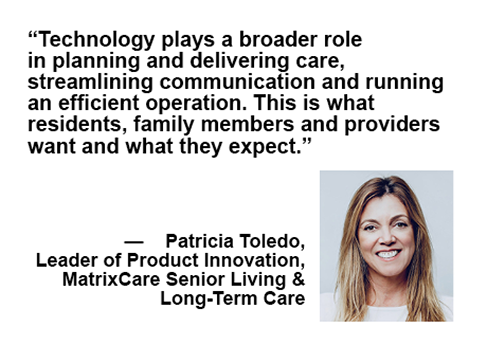Consumer expectations of technology are evolving due to a generational shift. Today’s senior living and long-term care residents and their family members are becoming increasingly tech-savvy. Their adeptness with digital solutions continues to grow with new technology.
Residents and their families’ use of these tools is expanding rapidly to include staying updated on health and activities, tracking medication, managing important documentation and overseeing finances. Electronic health records (EHRs) can assist in centralizing this information and can conform to the latest customer needs.
Residents and their loved ones expect easy access to information and quick responses from staff. They also expect providers to offer the latest advances in communication, case management and business operations.
Providers that fall behind in adopting technological advancements can struggle to remain competitive and relevant. In contrast, those businesses that adopt cutting-edge platforms can simplify and streamline their operations, not only becoming more operationally and financially sound — but most importantly — increasing the quality of their care.
Technology and Demographics
“Demographics are changing,” says Patricia Toledo, leader of product innovation at MatrixCare Senior Living & Long-Term Care. “The new generation of health-tech consumers are intrinsic members of the digital world.”
By 2030, one in five Americans will be retirement age, according to the U.S. Census Bureau’s population projections. About two-thirds of baby boomers already use smartphones, spending several hours a day on the devices.
The next generation of family members — Gen X and Millennials — grew up with technology and are adept at leveraging it. Text messaging, dashboards and a collection of apps (including voice and video messaging platforms) provide quick and easy ways to stay in touch with family and colleagues. How does this dramatic shift impact the senior living industry?
“Technology plays a broader role in planning and delivering care, streamlining communications and running an efficient operation,” says Toledo. “This is what residents, family members and providers want and what they expect.”
Demographics are also changing for clinical staff. Although labor shortages have gripped the industry, growing staff appreciation for tech has changed the field for the better. “Clinical staff are not chained to their desks — they are flexible tech adopters. They need faster access to resident information and insights to offer proactive and preventive care, which is critical for healthcare providers to succeed under the value-based reimbursement model,” states Toledo.
Evolving Care
Work is underway to build the EHR of the future — one that will incorporate the technology that is quickly becoming the standard of today and make room for the technology of tomorrow. This means embracing options such as artificial intelligence, voice recognition services and video technology.
Purpose-built solutions will need to be more comprehensive and transparent end-to-end. Systems must be built so that caregivers can communicate more freely and perform their jobs more efficiently, even as family members demand access to a personalized interface to check the status of a loved one in real time. “We are going to use technology to provide information faster and more easily,” says Toledo.
The EHR ecosystem of the future will be broader, connecting families, caregivers and clinicians. Each stakeholder will have access to the information they want and need in real time, according to Toledo.
Artificial intelligence (AI) will play an important role too. “A chatbot can be extremely helpful,” suggests Toledo. “In the near future, it will be able to quickly gather the right data to answer specific questions from clinicians, caregivers and family members. “We are incorporating AI in everything we do,” she adds, explaining that AI is driving both care and business solutions.
The EHR of the future will offer other benefits to senior housing and long-term care providers. Resident service plans will be created automatically from assessments. Data-driven workflows will make care suggestions more streamlined, comprehensive and personalized. Services provided to residents will be more easily and accurately documented. Actionable dashboards will let users quickly access the information they need and with fewer clicks.
“We want to eliminate the manual part of the workflow,” says Toledo. Caregivers and clinicians can spend less time on data entry. Automated text and the use of software applications will replace the significant amount of time caregivers spend on the phone with families or searching for resident information.
A more efficient workflow will also help to reduce employee burnout and turnover. Caregivers and clinicians will have more time to spend with the residents, providing person-centered care.
Business operations are being streamlined too. Sales and marketing teams will have easier access to leads, budgets and sales goals. Inquiries and referrals will be captured for faster processing. Census, vacancy and occupancy data will be available via one centralized system.
Payments Made Easier
The generational shift to embrace technology affects payments too, according to Heitor Barcellos, vice president of product management at MatrixCare Senior Living & Long-Term Care. “Senior living is one of the last industries to still use cash and checks,” Barcellos says. Most communities still rely on paper bills and receive paper checks as payments, which are expensive to process.

Meanwhile, the use of digital payments, including credit cards, for healthcare payments is growing quickly. A Grand View Research report estimates these methods of payment for healthcare alone will have a 21.5 percent compound annual growth rate between 2023 and 2030. Similarly, J.P. Morgan’s Trends in Healthcare Payments | Thirteenth Annual Report 2022 states that 91 percent of consumers prefer to pay medical bills electronically and 61 percent prefer to make those payments with credit or debit cards.
“Residents and families want to be able to make payments through the community’s portal,” says Barcellos. The payment system needs to be flexible and responsive to process funds. For example, two separate households could access the portal and split the bill using two different credit cards or through an automated clearing house (ACH) directly linking their bank accounts.
Peer-to-peer payments, including popular applications like Zelle, Venmo and Apple Cash, are also gaining in popularity. Over 80 percent of consumers report having used a peer-to-peer payment service, with 44 percent of these users employing the services at least once a week.
These direct payments could be the next frontier to streamline business operations. MatrixCare is working to incorporate peer-to-peer payments into its system. One of the services that’s being evaluated is the FedNow Service. FedNow is a new instant payment service that the Federal Reserve Banks developed to enable financial institutions to provide instant payment services in real time. The service was rolled out last July and may encourage additional consumer reliance on digitized payments.
“We are making it easy for the family and residents to make payments,” Barcellos notes. “There is a direct correlation between better management of financial metrics and the quality of care provided.”
— By Jane Adler. This sponsored content was written in conjunction with MatrixCare, a content partner of Seniors Housing Business.
Learn more about MatrixCare technology and the impact it can have for your clinical team.

